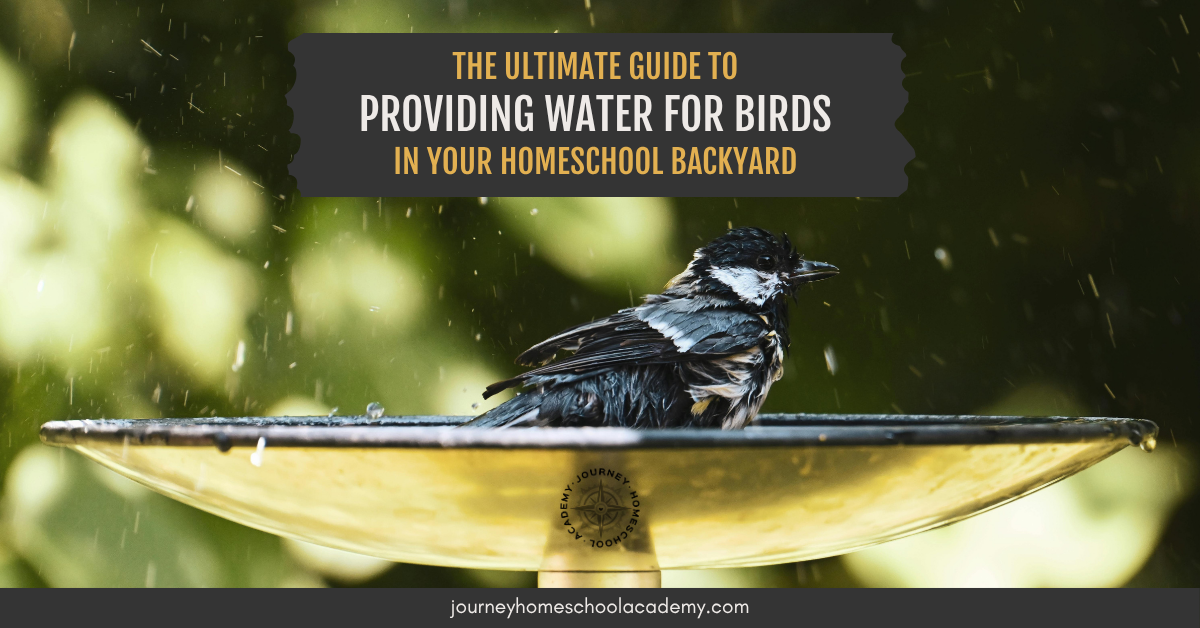If your homeschool days could use a little more fresh air, feathered friends, and easy science wins, providing water for birds might be the simplest nature study you ever add to your routine. It’s low-prep, inexpensive, and a fantastic way to help your kids connect with the natural world right outside your window.
Plus, once your kids discover that a single bowl of water can draw in robins, cardinals, chickadees, and even hummingbirds, you’ll start hearing things like, “MOM! There’s a blue jay in the bath!”—and honestly, that’s the good stuff.
This nature study also pairs beautifully with broader backyard science activities like feeder-watching (see All You Need to Know About Bird Feeders for Your Homeschool). But even by itself, a bird bath may be the easiest way to launch a whole new level of observation and wonder.
Let’s dive in!
The Ultimate Guide to Providing Water for Birds in Your Homeschool Backyard

Why Water Matters in Your Homeschool Nature Study
Every bird needs water, not just for drinking, but also for bathing. Bathing keeps feathers clean and fluffy so birds can insulate properly, escape predators quickly, and stay healthy.
For homeschoolers, adding a water source:
- Increases the number of birds your kids can observe
- Draws in species that never visit feeders
- Helps students slow down and observe behavior up close
- Creates natural journaling opportunities
- Encourages stewardship and gratitude for the world God designed (in a gentle, natural way)
It’s a simple step that transforms your backyard into a living science lab. And the best part? You can do it for under $10 if you want to.
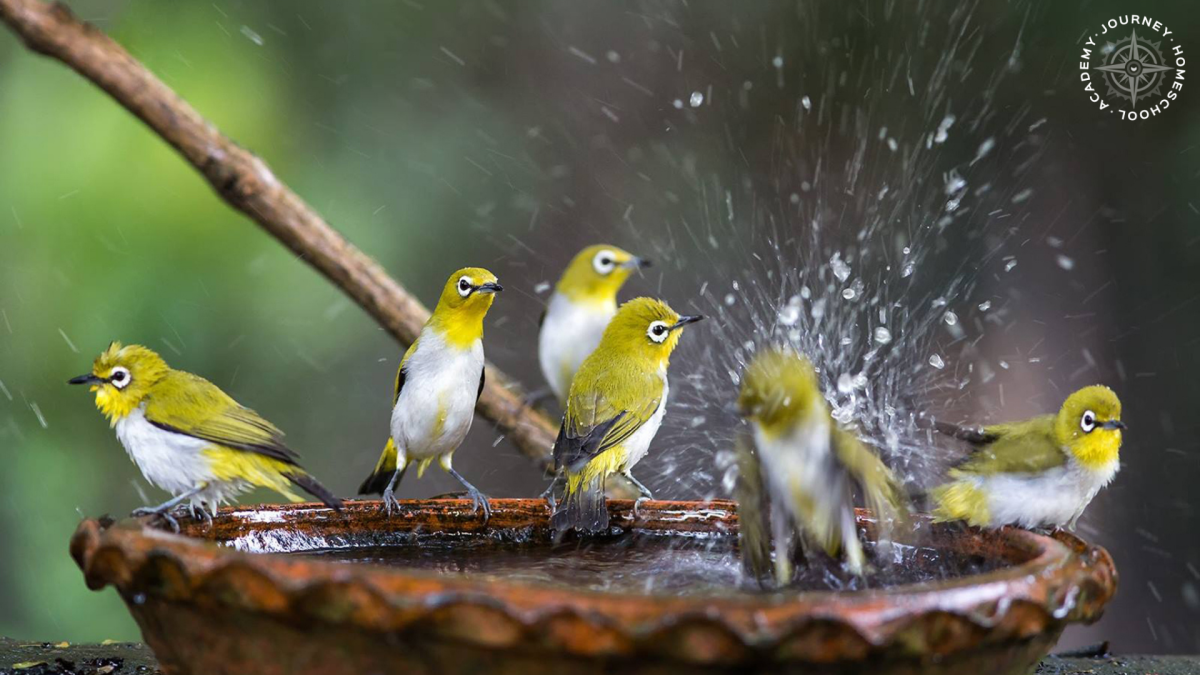
Simple Ways to Provide Water for Birds
Birds aren’t picky—they just need clean, shallow water. You can go simple or fancy depending on your budget and your kids’ level of enthusiasm.
Store-Bought Bird Bath Options
Pedestal Bird Bath – A classic, elegant choice. These are raised on a stand and work great in open yard spaces.
💡Tip: Place it where birds can see approaching predators (especially cats).
Hanging Bird Bath – Perfect for small spaces like patios or balconies.
💡Tip: Hang near a tree branch for quick escape routes.
Ground-Level Dish – Wonderful for ground-feeding birds like mourning doves, juncos, and sparrows.
💡Tip: Add a few stones so small birds can perch safely.
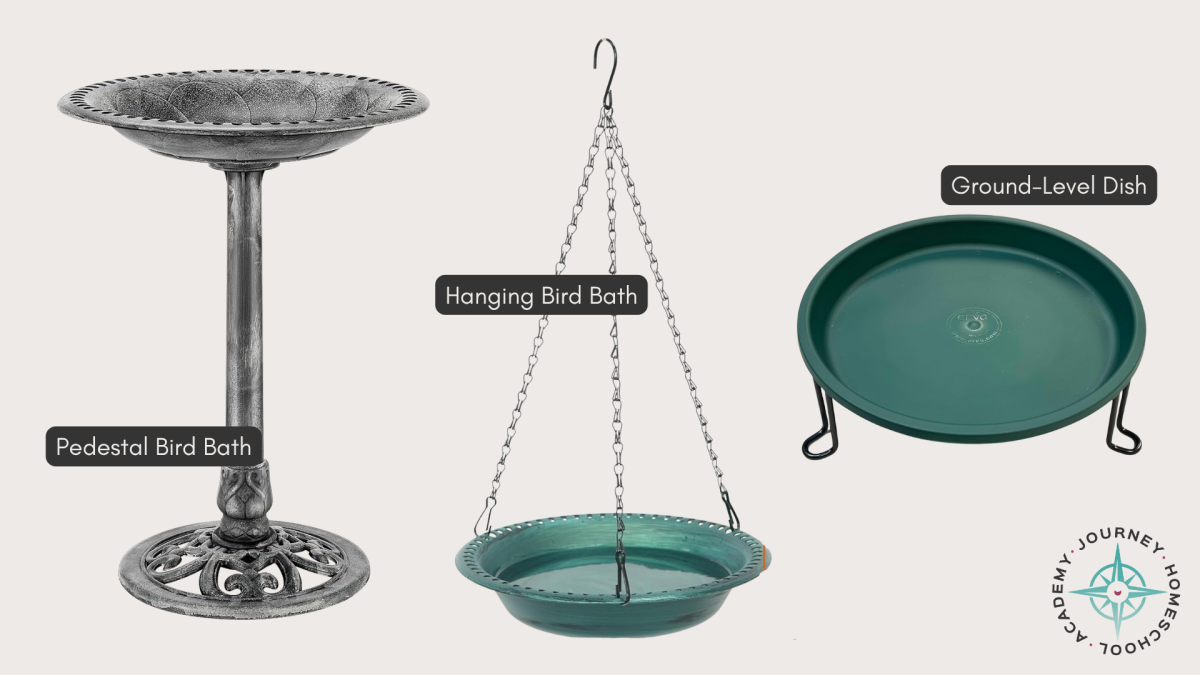
Easy DIY Bird Bath Projects (Kid-Approved!)
1. Terra Cotta Saucer Bird Bath
This may be the easiest homeschool science project ever.
- Tutorial: https://nourishandnestle.com/diy-bird-bath/
- Use a terra cotta saucer + an upside-down flower pot.
- Paint optional! Your kids will probably want to paint.
2. Upcycled Serving Bowl Bird Bath
Charming, quirky, and great for eco-friendly lessons.
- Tutorial: https://www.homejelly.com/weekend-diy-project-how-to-make-a-cute-serving-bowl-birdbath-for-5/
- Use a pretty bowl from a thrift store and mount it on a plant stand or stump.
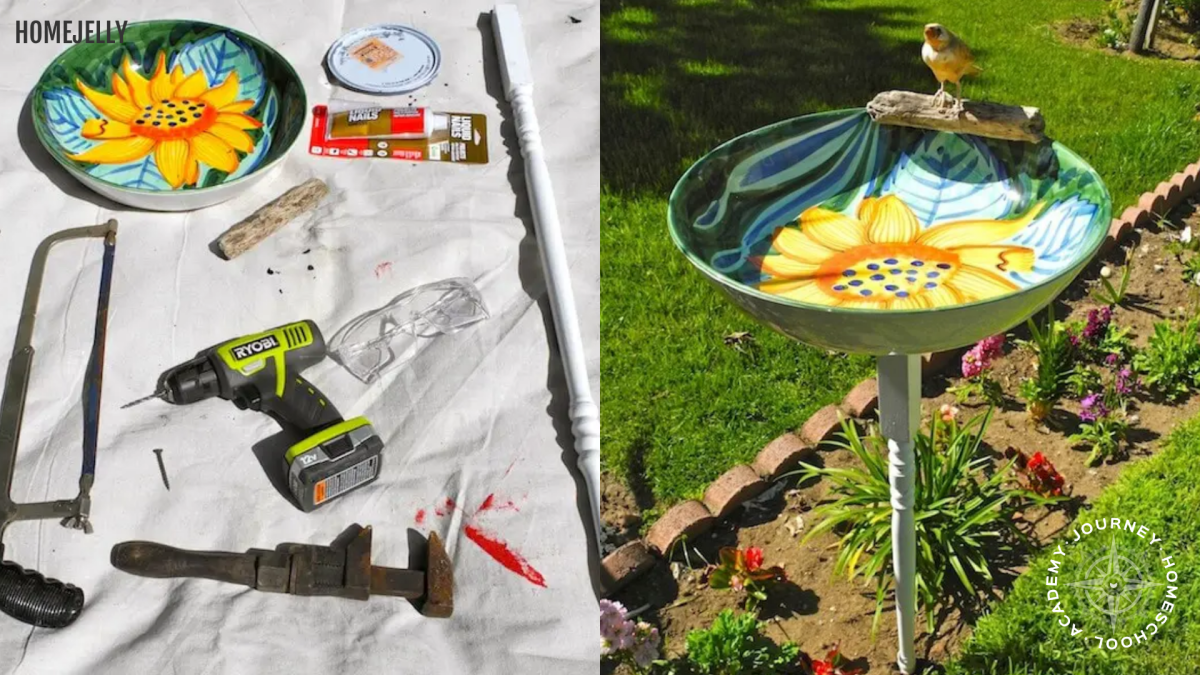
Adding Moving Water to Attract Even More Birds
Birds LOVE moving water. The sound catches their attention, and moving water often stays cleaner longer.
Solar Fountain Pump
Float these in any shallow dish to create a tiny, bubbling oasis.
- Solar Pump: https://amzn.to/4qWyrZ5
Why it’s great: No wiring, no setup, and your kids can watch how sunlight affects the strength of the fountain—hello, bonus science lesson.
Drippers & Misters
These attract hummingbirds faster than sugar water.
- Dripper: https://amzn.to/4nZ5xVF
- Mister: https://amzn.to/4nTGOlt
They also create small puddles, meaning multiple bird species can enjoy the water at once.

Nature Observation Activities for Your Kids
Providing water is just the first step, now the nature study begins!
Bird Behavior Journaling
Encourage your kids to record:
- Which species visit
- What time of day they appear
- Whether they drink, bathe, or “splash-fight”
- Differences between males and females
- Seasonal changes
Journaling strengthens writing skills and observation skills at the same time.
Journal prompts:
- “What bird visited the bath today?”
- “What did it do?”
- “Draw the splash pattern!”
- “Did new birds appear after adding moving water?”
Mini STEM Investigations
Try these simple activities:
- Evaporation study: Measure how much water disappears each day.
- Behavior comparison: Observe how birds use still water vs. a solar fountain.
- Species graphing: Chart which birds appear most often.
➡️Check out our previous blog on “Why Create a Bird-Friendly Backyard for Your Homeschool Science Lessons”
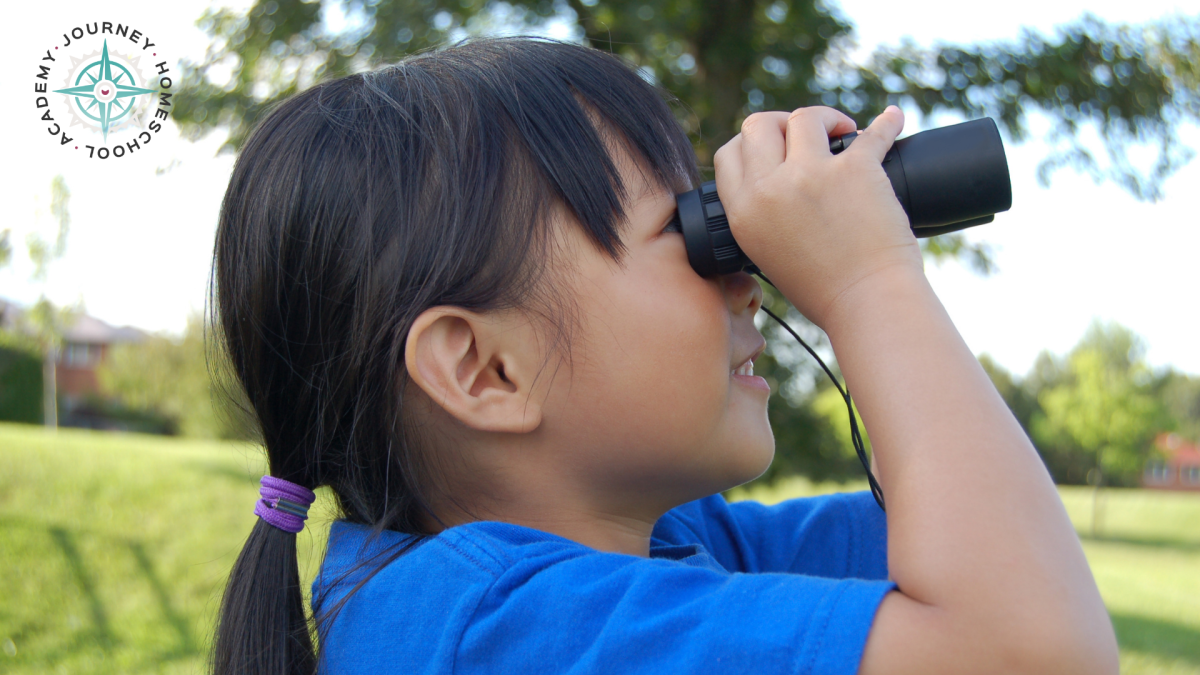
Keeping Your Bird Bath Clean & Healthy
A clean bath keeps birds safe and attracts more species.
Simple Weekly Routine
- Change the water every 2–3 days.
- Scrub weekly with a water + vinegar mixture (no soap).
- Keep water shallow—1–2 inches max.
- Add rocks or marbles for small bird footing.
Seasonal Adjustments
- Summer: Move to a shady spot to reduce algae.
- Winter: Use warm water refills or a small heater (for your climate).
Teaching your kids to care for the bath reinforces responsibility and gentle stewardship.
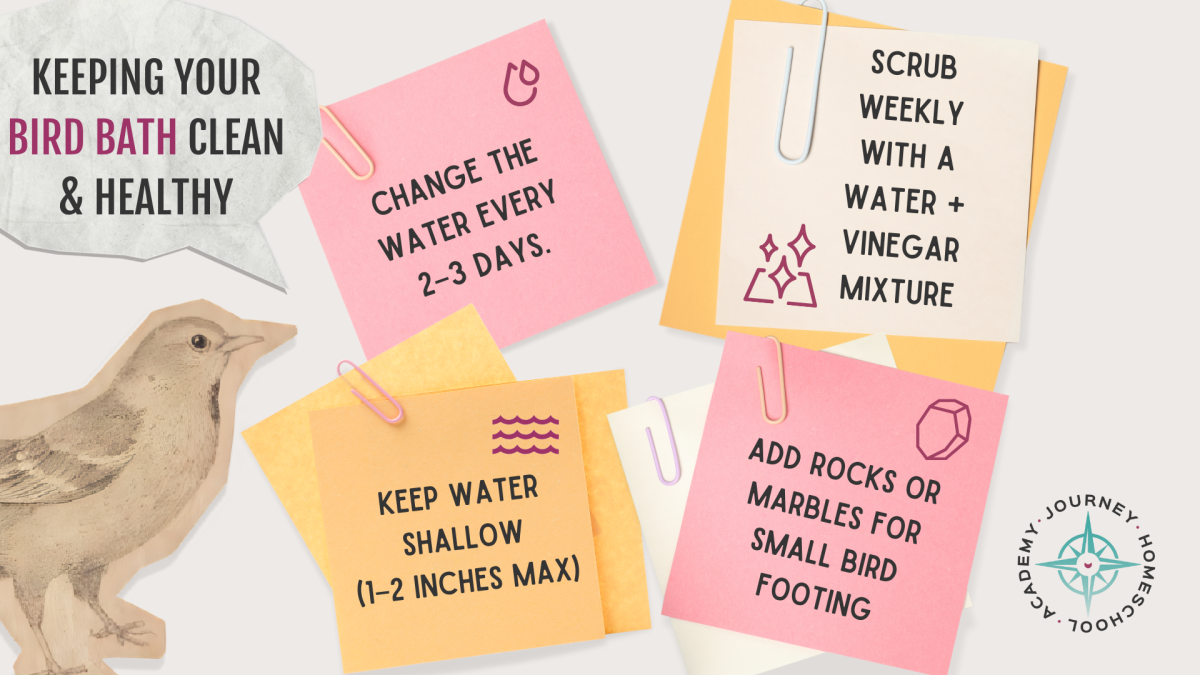
Extend the Learning with the “World of Birds” Course
If your kids are loving this simple nature study, they’ll be thrilled about JHA’s upcoming World of Birds course, especially because water studies like this one lay the perfect foundation.
It’s all about hands-on observation, field journaling, and discovering the wonder of birds through real-life science. It will be available any time after January 1, 2026.
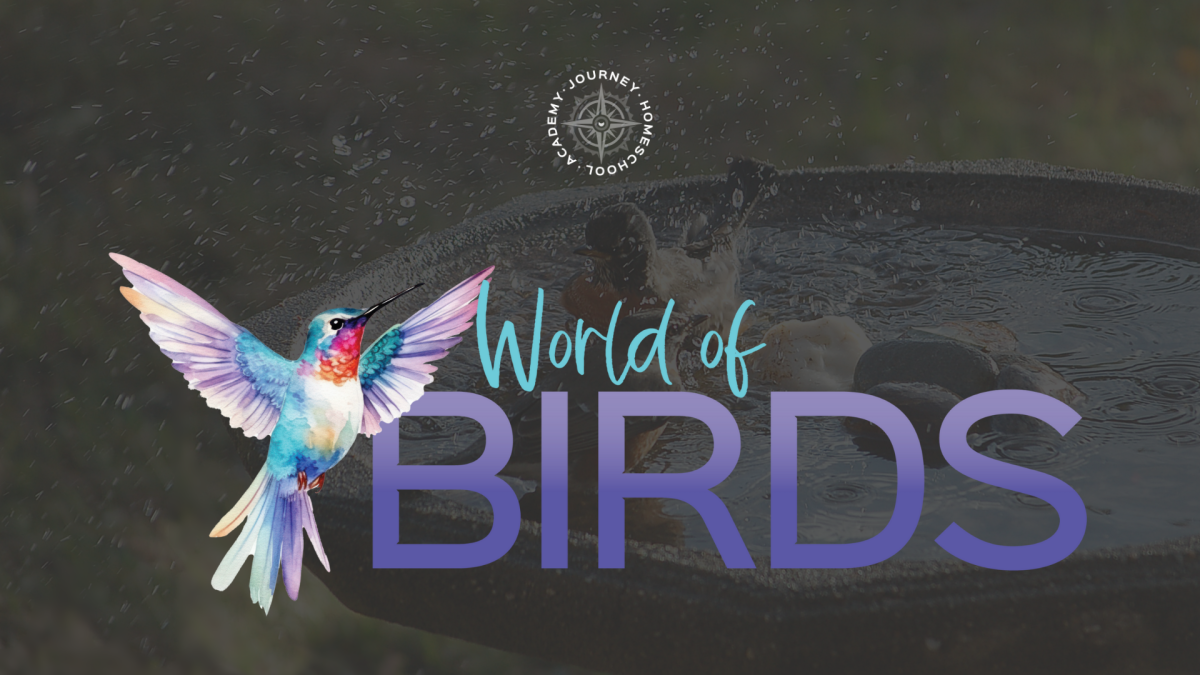
Final Thoughts: Big Learning from Small Steps
Providing water for birds is simple, but it creates some of the richest homeschool science moments you’ll experience.
Kids learn to observe, record, wonder, and care for the creatures God has placed in their world. And as parents, we don’t have to be expert ornithologists to spark that curiosity. We just have to offer a little water and make space for discovery.
So set out a bowl, invite the birds, and enjoy the beautiful backyard science adventure that unfolds!
